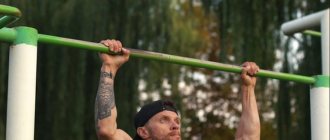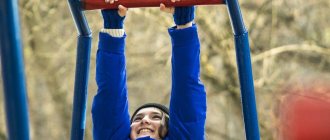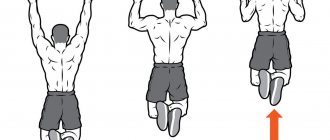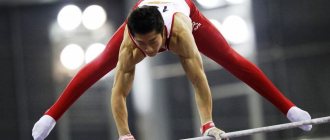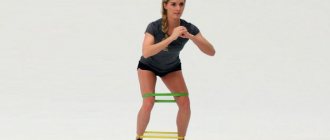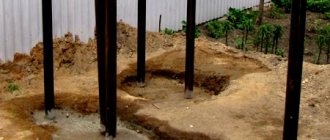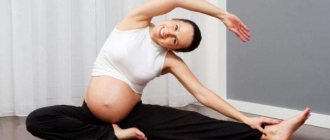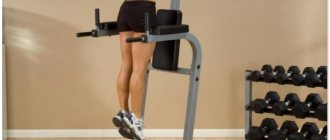Hello. Dear friends! Undoubtedly, the health of children directly depends on their physical development. And it is important for us, parents, not to lose sight of this important point. Not long ago I was faced with a serious problem: how to teach my 12-year-old child to do pull-ups on the horizontal bar?
Indeed, this is not an easy task. Especially if your son is not at all prepared for this. And that’s why today we’ll talk about how and where to start doing pull-ups from scratch!
Unfortunately, this issue is not always resolved in a week. For example, it took my son and I almost six months to learn how to do pull-ups on the horizontal bar!
In addition, we will once again remember what great benefits this exercise brings to our body. I also shared my personal experience.
Benefits of exercise
Any sport has a general strengthening effect on the body, provided that it is practiced constantly, in compliance with all safety rules. According to experts, pull-ups on the horizontal bar are the second most effective exercise after swimming for strengthening the muscles of the back and arms. The indisputable advantages of this activity also include:
- improved posture;
- strengthening the cardiovascular and skeletal system;
- strengthening the muscles of the arm, including the hand, which contributes to the development of fine motor skills;
- development of endurance, perseverance and patience;
- improved coordination of movements.
According to statistics, in Russia from 15 to 25% of children and adolescents are overweight. Excessive fatness is not an obstacle to exercise on the horizontal bar; on the contrary, regular exercise in combination with a diet will help correct your figure.
Advice. It is believed that pull-ups are a purely boyish sport. But a healthy spine and beautiful posture are also necessary for girls, so it is advisable for parents of children of both sexes to know how to teach a child to do pull-ups on a horizontal bar.
Why do you need pull-ups on the horizontal bar and the specifics of the exercise?
Exercising on the horizontal bar improves endurance. The versatility of the exercises is that they can be performed by children of different ages. It is only important to correctly calculate the load so as not to harm the growth and development of the baby. Exercises for children are divided by age, usually up to 10 years and after.
Good to know!
Exercising on the crossbar is an excellent prevention of spinal diseases.
The benefits of pull-ups for a child
Classes on the horizontal bar are suitable for both boys and girls. Lifting your own weight is safe and does not cause injury. The main benefits of exercise:
- Posture improves.
- Positive effect on blood vessels and heart.
- The muscles and bones of the hands are strengthened. Fine motor skills improve.
- Develops patience, endurance and perseverance.
How to calculate the load
Children can withstand different loads depending on their age. This is directly related to physical development. Main categories:
- Children under 3 years of age should exercise for about 25 minutes a day, no more.
- You can practice for 30 minutes at the age of 3-6 years.
- After the 6th birthday, you can increase the time of exercise to 45 minutes. Training can be more intense.
Classes on the horizontal bar should be carried out about 4 times a week, no more.
This load is considered optimal for the child’s body. At the same time, it is better to do exercises daily to keep your baby in good shape. You should not suddenly load your son or daughter; the number of pull-ups should be increased gradually, starting with just 1 time.
How many times should a child be able to do pull-ups?
After the first successful exercise, the baby will quickly become motivated and want to do more. As a rule, the results are not long in coming; progress is quite rapid. There are certain standards for pull-ups for children of different ages:
- 6-8 year olds perform 2 – 4 times;
- at 9-10 years old do 2 – 5 pull-ups;
- 11-12 year olds – from 3 to 7 repetitions;
- at 13-15 years old from 4 to 10 times.
It will not be possible to achieve such a result instantly.
It’s worth starting with one pull-up and gradually changing the load to the desired level, increasing the number of approaches. This way the load will be even. Instead of doing 6 pull-ups in a row at age 6, it’s better to do 3 sets of 2 reps.
See also:
How to dress a child according to the weather - a table for each age
Assessment of a child's physical fitness
Excessive exercise discourages the desire to exercise and can harm your health.
Therefore, before teaching, you need to develop an individual training program to determine the child’s level of readiness. The following rough plan will help with this:
- Invite your son or daughter to hang on the horizontal bar, clasping the bar with your palms facing away from you, from a reverse grip position. If the child is hanging freely, without visible effort, ask him to slightly bend his arms and pull himself up. A sign of good physical shape is the ability to lift your body at least a few centimeters.
- It doesn’t matter if you can’t pull yourself up at the initial stage. Record the time how long the baby can simply hang on the horizontal bar. Holding your own body weight for a minute or more is a good result.
- A child who is unable to stay on the bar for more than 10 seconds needs training. A donut-shaped rubber expander is suitable for this purpose. To strengthen your hands, it is enough to exercise several times a day for two weeks. You can train casually, without leaving your apartment, while watching TV, talking or reading a book.
- General strengthening exercises are desirable for all children, both strong and weak. The main ones include push-ups, running, jumping, squats, and exercises with dumbbells.
This is interesting. Questions often arise at what age to start training. Pull-ups from infancy are not uncommon. The innovative teachers Nikitins were among the first to introduce such a practice back in the 70s of the last century. For the early development of fine motor skills of the hands, a crossbar was installed in the crib of a 3-4 month old baby, which he could grab onto if desired.
Now some mothers and fathers teach children to do pull-ups as early as six months.
Readiness degree
When is the time to teach boys (and pull-ups are necessary, first of all, for them)? In principle, a baby can hang on a crossbar from the age of one and a half years. Next, he will learn to climb the horizontal bar and wall bars. But pull-ups require fairly good physical shape.
In order for a baby to pull himself up, he must have strong and strong:
- Hands;
- abdominal Press;
- forearms;
- pectoral muscles;
- biceps;
- triceps;
- back muscles.
The physical demands are quite severe. You can teach a child to do pull-ups no earlier than he reaches the desired physical shape. This is not so much a question of age as of the readiness and desire of the baby himself. In sports families, children begin to pull themselves up long before they start school, especially if they attend any section. But in most cases, the question arises precisely in elementary school, when the boy suffers his first failures in physical education lessons. Therefore, it makes sense to pay attention to working with the horizontal bar in older preschool age.
If time was wasted and your son did not learn to do pull-ups before school, do not scold him for his failures when he shares with you that he could not fulfill the standard in physical education. This can cause an inferiority complex, isolation, and aggression. It’s better to tell your son that it’s time to get serious about this important issue, and help him master a difficult skill.
Useful tips
For horizontal bar classes to be successful, it is important to get your child interested in them. The following methods are suitable for motivation:
- Personal example . Seeing how energetically the father pulls himself up, the son will probably want to try to repeat the actions. Joint activities will captivate both the child and the father.
- Motivational literature and films . Fragile and weakened children will be interested in reading the biography of famous athletes, whose path to awards lay through obstacles in the form of illnesses, injuries, and impotence.
- Psychological support at any stage . The desire to lead a healthy lifestyle and engage in physical education is fostered from early childhood. With older children, you need to talk about the need for classes, emphasizing the results from them: a beautiful figure, cheerfulness, energy, strength.
Before starting classes, you need to take the following safety precautions:
- Proceed to exercises only after warming up.
- If necessary, support the baby using physical force so that he can pull himself up.
- It is advisable to remove small children from the horizontal bar yourself; schoolchildren need to be explained how to jump off correctly, sitting on their toes.
- The increase in load should occur gradually, as the muscles strengthen, and without fanaticism.
- If lessons are held in a room, you need to clear its space of unnecessary objects.
Negative repetition method
For a beginner who has never performed this kind of exercise in his life, it is important to have information on how to learn how to do pull-ups without a horizontal bar from scratch. For these purposes, a special technique called the negative repetition technique is suitable. The exercise can be performed independently in any convenient place. For these purposes, you don’t even need a crossbar.
The essence of the exercise is to pre-train the body and fix the body in a special position, characteristic of a pull-up. Just stand on a stool, raise your arms up, grasping an imaginary horizontal bar with a wide grip (with your fists shoulder-width apart). Next, you should make movements with your body, as if lifting it up, lowering it down. You should learn to perform the exercise smoothly and slowly, carefully working all the muscle groups involved in it. In one approach you should do about 5-7 imaginary pull-ups. At the same time, it is recommended to do no more than 3 approaches during the day.
Beginner athletes who cannot yet do a single pull-up will benefit from training with a partner. To do this, place your assistant behind you so that he can help you lift your body up and secure you in case of any surprise. Remember that when training with a partner, most of the effort should come from you.
A week of such preliminary training - and you can start doing exercises on the horizontal bar. Your muscles will be fully prepared to perform pull-ups,
Preparatory exercises
A training complex specially selected for children will make learning easier. Your baby will be able to pull himself up for the first time by strengthening his arm and back muscles with the following exercises:
Plank
From a lying position, face down, with straightened legs brought together, the child sharply pushes off the surface, straightening his arms.
The hands are located under the shoulders. The legs, head, stomach and back should form a straight line. The point of the exercise is to hold in a static position for at least 30 seconds.
For the first time, two approaches are enough, then the load gradually increases.
Plank on left or right hand
At the initial stage, the exercise is performed similarly to the first. Lifting off the floor, you need to press one hand tightly to your body, holding your body weight with the other.
Push ups
Having mastered the plank, you can move on to push-ups. The starting stance is the same, but your hands should be placed a little wider. By bending them, the performer lowers himself lower and lower, without touching the surface with his knees or stomach. When the distance between the floor and the body is reduced to 3-4 cm, you need to gradually straighten your arms. The number of repetitions and approaches depends on the level of training of the little athlete.
Back Raise
Lying with your chin down, straighten your arms to your torso. The child's legs must be fixed, for which an adult holds them with his hands. The baby should raise his upper body, bending at the waist and directing his gaze upward.
The muscles of the back and abdomen work.
boat
From a lying position, face down, the baby raises his straightened arms and legs, looking up.
Pull-ups
This exercise is recommended for children who have already mastered the previous ones. Grasping one of the bars with both hands, you need to throw your legs over the other so that your bent knees are located above it. Then you need to pull yourself up and touch the beam with your chin, holding for a few seconds.
Emphasis on straight arms on the horizontal bar
The exercise is performed on a low bar located at groin level. Leaning your hands on it, you need to move your shoulders slightly forward and pull your lower body up.
Movement on the bar while hanging
The baby moves along the pole using his hands. The device should be positioned higher so that your feet do not touch the ground.
To strengthen the muscles of the back and abdomen, also perform abdominal exercises.
Advice. To avoid making your workouts dependent on weather conditions, it is better to exercise in the gym or at home. It doesn’t matter where the equipment was purchased, in a sports store or secondhand, the main thing is to install a children’s horizontal bar or wall bars in the room in accordance with all safety rules.
Features of teaching pull-ups for children under 10 years old
From the age of 1.5 years, you can introduce a boy or girl to sports. During classes, you need to help the baby, always support him not only morally, but also physically. At the very beginning of training, it is better to approach the issue in a playful way. Children under 10 years of age are very active, but are not always able to control energy and concentrate.
If there are older brothers or sisters in the family, then you can set them as an example. If not, then parents should show how to do the exercises. It is important to ensure that the pull-ups are performed smoothly.
Kids are quite active, but jumping off the horizontal bar can lead to spinal injuries.
Start classes only when the baby masters the grasping reflex. First, teach how to simply hang on the horizontal bar. A good solution would be a wall bars with a ladder. Then the child will be able to climb onto the crossbar without much difficulty.
Raise the baby so that the chin is above the level of the bar. Maintain it as you slowly lower your body. Only when the baby can control the smoothness of his movements can he move on to a more difficult stage - independent lifting.
See also:
What to give a 10 year old boy for his birthday?
https://youtu.be/Hu63pCniqfw
Effective lesson plans
Do not rush with real pull-ups: with a sharp grip, there is a high risk of sprained ligaments or displacement of the vertebrae. First, it is recommended to master various techniques to make the task easier. For example, these:
Assisted pull-up
An adult helps the little athlete hold and move his torso upward by wrapping his arms around him at the level of his stomach.
Simulating pull-ups on the wall bars
During this exercise, your knees rest against one of the bars. With this method, part of the weight rests on the support, making the exercise easier.
Pull-ups with devices
To perform this, a chair or special sports equipment is installed under the crossbar. You need to stand on a support, rest your chin on the horizontal bar and hang on your arms bent at the elbows.
Then slowly move your torso down. It is possible that gravity will force you to straighten your arms quickly the first time, but as you practice, the downward movement will become slower each time.
Pull-up with a tourniquet
A special expander with a plate in the center or a durable tourniquet is installed on the horizontal bar. A child performs pull-ups while standing on a device. The tension of the tourniquet can be adjusted if desired; the stronger it is, the easier it is to pull yourself up.
Check out this video to see what other great exercises you can do to master the pull-up skill:
As for food...
...then here, according to the leading researcher at the Research Institute of Nutrition of the Russian Academy of Medical Sciences, Doctor of Medical Sciences, Professor Arseny Martinchik , the rules are simple:
● Food should be varied and balanced. Most of all you need to eat cereals and flour dishes - 6 servings per day. (It is considered this way: porridge for breakfast - a portion, bread from sandwiches - a second, pasta as a side dish during lunch - a third...) Vegetables and fruits - 2-4 servings. Fish, meat, milk should be eaten twice a day. A guy who wants to build muscle should add an extra serving of dairy products to his diet.
● Boys 14–15 years old eat a lot; at this age they have the highest energy needs, they need 3 thousand kilocalories per day. But those who play sports should consume even more - 3.5 thousand kilocalories, that is, eat one and a half times more than dad.
● And no steroids, anabolic steroids... Medicine firmly says “no” here. The production of his hormones may be disrupted, and then the guy runs the risk of not having children in adulthood.
Example lesson
The lesson process step by step can be as follows:
- Small gymnastics – 2–3 minutes.
- Exercises for preparation: push-ups, plank, pump.
- Hanging on the horizontal bar – 2 sets without pulling up, 20–30 seconds.
- Pull-ups with support or incomplete.
- Moving along the bar while hanging using your hands.
- Exercises for legs and abdomen: raising legs and body.
The technique can be changed slightly depending on the physical condition of the baby.
Program for beginners: 1-5 pull-ups
The desire to be in shape requires a lot of effort. You don't have to spend time in the gym to achieve results. You can strengthen your muscles and pump up on the street using a horizontal bar. Doing pull-ups on the horizontal bar after a week from 1 to 5 times is a real and doable task.
To do more than 1 pull-up, at the first stage you need to follow this scheme:
- Constantly hanging on the bar and push-ups are the first exercises that will help you pull yourself up from scratch and increase muscle mass.
- Lifting kettlebells will also benefit your shoulder girdle.
- Once the zero barrier is crossed, it's time to increase the number of repetitions. To do this, you should train by doing pull-ups 1-2 times for 10-12 approaches, resting for 20-40 seconds. If you can only pull yourself up once, it is better to increase the break time.
- Training with different grips will allow you to do more pull-ups with a regular grip.
After a month of regular training, most beginners can do 5 or more pull-ups.
How to do pull-ups correctly
It’s good if adults have experience in sports training. They will be able to point out to the child his mistakes and correct his actions. Correct pull-ups on the horizontal bar consist of several stages:
- Starting position: you need to grab the bar and hang with your arms outstretched. The body and legs should form a straight line, the limbs should be straightened, the hands should be positioned slightly wider than the shoulders. The main load is distributed on the muscles of the arms and back.
- Lifting the torso up. The effort is carried out while inhaling.
- Arm bending. Hanging on bent arms is not recommended, as holding in this position requires effort and can lead to overexertion.
- Extension of the arms and return to the starting position. It is wrong to sharply reduce your body weight. The muscles must work both on the ascent and on the descent, otherwise you can fall off the horizontal bar.
If you have doubts whether your son is performing the exercise correctly, watch a video lesson of how a boy does pull-ups on a horizontal bar, or consult a physical education teacher.
Is it possible to teach a child to do pull-ups in a week?
In just 1 week you can teach your baby just the right technique. With fairly good physical preparation, the son or daughter will be able to perform the first full exit in 7-10 days. But it is difficult to estimate how long it will take a particular child to fully master the exercises on the horizontal bar. Much depends on your initial physical preparation.
On a note!
If you regularly perform a full set of exercises, after 2-3 months the baby will be able to do the norm. Boys and girls over 10 years of age may need up to 4 months. If a small athlete is thin, then prepare for 30 weeks, and if he is fat, for 50-60.
When studying, focus on preparation. Only after improving your physical condition is it worth working on the correct technique. Do not violate the algorithm of classes, even if it seems that it will be easier for the baby. Improper pull-ups on the horizontal bar can cause damage to your hands and arm muscles.
Young children are more agile and energetic, so they achieve results faster. At the same time, they are quite restless, so the lion’s share of the time can be spent practicing the correct technique. After 10 years, the technical part is better mastered, but difficulties may arise directly with the full lifting of the body. This is why a child can be taught the correct technique in 7 days, but tangible results from the classes will come later.
https://youtu.be/krjY7tglHt0
See also:
Where to celebrate a child's 10th birthday?
